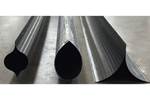Second NASA contract received by AnalySwift progresses high-fidelity composites design tool
Research funded at Purdue University, University of Texas at Arlington will produce a computer tool to exploit tailorable composites, hybrid material systems for a variety of broad applications.
Wenbin Yu, professor in Purdue’s School of Aeronautics and Astronautics and primary investigator for the project. Photo Credit: AnalySwift LLC
For the second time in a year, commercial software provider AnalySwift LLC (West Lafayette, Ind., U.S.) has received a contract from NASA (Washington, D.C., U.S.) to develop a design tool for tailorable composites and hybrid system materials.
The 13-month, $156,490 Phase I Small Business Technology Transfer (STTR) contract is for the dedicated project “Tool for Thermomechanical Design of Tailorable Composites and Hybrid System Materials.” It will fund research to be conducted at AnalySwift, Purdue University’s (West Lafayette) and the (UT Arlington).
Allan Wood, AnalySwift CEO, says the company will have developed an efficient, high-fidelity computer tool at the end of the project. It will be capable of accurate, thermomechanical design of materials beyond the traditional approaches for conventional composites.
“This research will benefit NASA by exploiting the full potential of tailorable composites and hybrid material systems,” Wood adds. “They can endow lightweight space structures with reduced thermal sensitivity while retaining their strength and stiffness. Applications of interest to NASA include lightweighting exploration vehicles, space habitats and other space hardware, as well as enabling challenging performance characteristics.”
Wenbin Yu, professor in Purdue’s School of Aeronautics and Astronautics, notes that there are four challenges to designing tailorable composites and hybrid materials systems compared to conventional materials:
- They have curved and/or discontinuous fibers whose orientation varies by location.
- Their strength and stiffness vary by in-plane location.
- Their location-dependent strength and stiffness couple structural design with material design.
- They can be made through synergistic use of metallic alloys, short and/or continuous fiber reinforcements and a variety of matrices.
Wood says there are two main technical barriers to using tailorable composites and hybrid material systems to their full potential — both have to do with design tools.
“First, most tools are based on a theory and rules that rely on assumptions applicable to conventional materials,” he explains. “There is a need for advanced design models capable of accurately modeling tailorable composites and hybrid system materials without ad hoc assumptions.
“Second, most works are aimed at solving simple problems involving idealistic structures, which result in special-purpose codes. There is a need for theories and codes that are ready to be integrated into third-party commercial codes like MSC Patran, NASTRAN and Abaqus for the design of real structures composed of these next-generation materials.”
Yu will be the primary investigator in the research to create the new design tool. Liang Zhang of AnalySwift and Xin Liu of the University of Texas at Arlington will be co-investigators.
“The final design tool will be broadly applicable to various NASA uses, including lightweight structures for antennas, landers, rovers and solar arrays; airframe technology like a hybrid/blended wing body; and highly fatigue- and damage-tolerant structures for vertical lift aircraft,” Yu says. “The STTR contract from NASA will bring us from ideation to a final, government-endorsed tool quicker than other contracts or investments would support.”
Related Content
-
Plant tour: Aernnova Composites, Toledo and Illescas, Spain
RTM and ATL/AFP high-rate production sites feature this composites and engineering leader’s continued push for excellence and innovation for future airframes.
-
“Structured air” TPS safeguards composite structures
Powered by an 85% air/15% pure polyimide aerogel, Blueshift’s novel material system protects structures during transient thermal events from -200°C to beyond 2400°C for rockets, battery boxes and more.
-
Industrializing additive manufacturing in the defense/aerospace sector
GA-ASI demonstrates a path forward for the use of additive technologies for composite tooling, flight-qualified parts.






